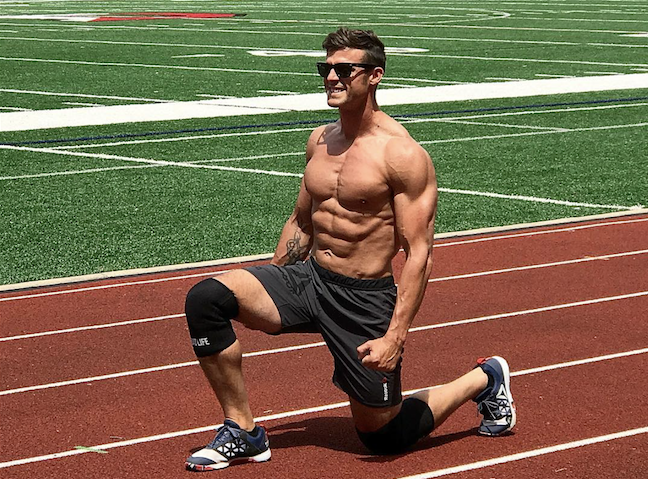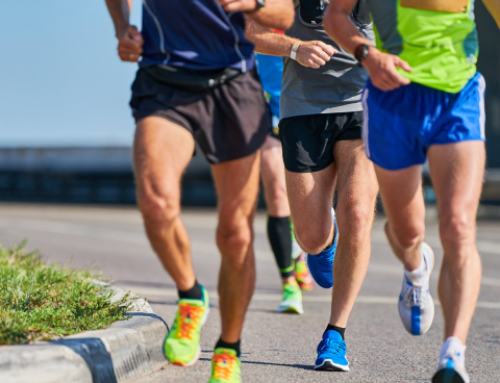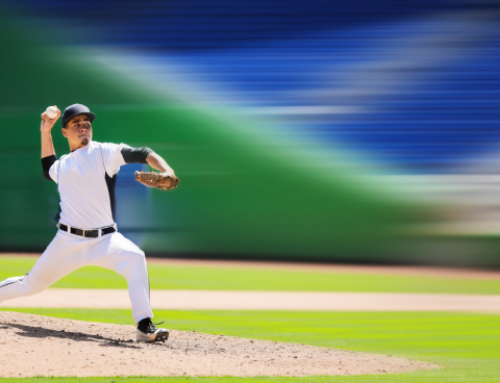Lunges have been at the foundation of my GPP (General Physical Preparedness) work for quite some time. I am known in my area for being the crazy lunge guy. My best lunging workouts are 1 mile straight with a 40-pound vest, 3/4 mile with an 80-pound vest and 400 meters in 8 minutes and 17 seconds. These are all touching my knee on each step and keeping proper form. I normally lunge 4-5 times a week for 400 meters when I am fine with my body weight or conditioning, and 800 meters when I wanna get more ripped. Most of my athletes lunge for 400 meters 3-4 times a week.
I began throwing Lunges into my program for several reasons: great conditioning (I hate running), they made my entire posterior stronger, and my connective tissue started to feel fantastic. If I break it down, I wanted my legs to be jacked for being a bodybuilder, strong as hell for powerlifting and durable long-term for all the crazy stuff I do on a regular basis. The added bonus is leg endurance and a raised metabolism.
I don’t recommend something unless I have tested it before, so when I discovered the magic of Walking Lunges, I shared my experience and knowledge on the subject with others. Some of these people included different types of athletes such as pro football players, baseball players and others. Below are three athletes who would see a huge step-up in their game from incorporating Walking Lunges.
Walking Lunge Benefits for Baseball
There are numerous baseball players who follow my programming, and for good reason. Baseball is an interesting sport because there isn’t action going on the entire time. However, when it comes time to spring into action, players must be ready. That being said, here are a few movements in baseball that stand out when it comes to thinking about how Lunges are useful.
The pitcher. When a pitcher goes through his motion and plants his back foot against the rubber, he must be able to drive significant force into the ground to push off to translate velocity into the baseball. What muscles do you think are generating this incredible force? The hips, the glutes, the hamstrings, etc., are going to be the main movers here.
Infielder. Some of these guys have more ground to cover than others. When a ground ball is hit, the fielder often has to move laterally to field the ball. To move athletically side to side, you must be explosive below the waist. The quads, adductors, posterior chain, etc., have to all be firing for you field some of the balls that otherwise would be base hits.
Walking Lunge Benefits for Football
Football is one of the most aggressive, most demanding games there is in sport. Especially if you are trying to compete at a higher level, it is imperative that you develop quickness, explosiveness and many other attributes to perform.
For the sake of this article, I’ll talk about a running back. A running back traditionally starts behind the quarterback and is handed the ball several times during the course of the game. Much of the time, the RB has to think instinctively where he’s going to make his move against the defensive player. Is he going to plant his right foot into the grass to cut left? Is he going to double juke to catch the defender on his heels? The running back has to continually think on his feet during a game to gain more yards and ultimately score more TDs for his team.
I’ve worked with different NFL running backs, and once they tried this it was undeniable weeks later. When you are in the NFL for multiple seasons, it certainly wears on you. You need some sort of insurance policy for your body and you must take care of it. You have no choice because your body will literally start to break down. Lunges are a part of that insurance policy. They will assist in keeping connective tissue strong, keeping muscles firing correctly, and keeping them strong!
Walking Lunge Benefits for Endurance Athletes
Think marathoners, cross country runners or triathletes. Many of these athletes are pounding the pavement day after day, logging countless miles in their training. Sure I don’t have the most experience in the running world, but I do know that by adding Lunges or even replacing a day or two of their training with Walking Lunges would make a positive impact in their training and races.
I confidently know this because my joints are under daily stress from all the squatting I do. The Lunges will build a stronger, more solid posterior chain, and it will make the connective tissue around your knees, for example, feel much better. If you talk to most runners, running less is definitely counter to the conventional way of doing things. If you are a runner who is skeptical, give it a try, because I bet you won’t regret it.
Walking Lunge Workouts
First and foremost, you need to have good Lunge form. A couple key points to remember when you’re performing Walking Lunges is to keep your knee aligned over your ankle, and your knee shouldn’t travel forward beyond your toes. Avoid taking steps that are too long or you will turn the exercise into a hip flexor stretch. Also, keep your torso upright or slightly tilted forward, and make sure to keep your core tight and back flat.
I like to lightly touch my back knee to the ground to make sure I’m moving through a full range of motion, so I wear knee sleeves to protect my knees. If you don’t have sleeves, do your best to get your knee as close to the ground as you can without touching.
Now for the workouts. Do one of the below options as a finisher at the end of your lifting session.
Option 1 – Power: Walking Lunges for 400 meters (.25 miles)
Option 2 – Conditioning: Walking Lunges for 800 meters (.5 miles)
The goal is to complete the workouts in as little time as possible. Track your time so you can compete with yourself the next time you do the workout. Your first experience might be miserable, but you should eventually be able to complete each workout while wearing a 40-pound weight vest.
READ MORE:
RECOMMENDED FOR YOU
Lunges have been at the foundation of my GPP (General Physical Preparedness) work for quite some time. I am known in my area for being the crazy lunge guy. My best lunging workouts are 1 mile straight with a 40-pound vest, 3/4 mile with an 80-pound vest and 400 meters in 8 minutes and 17 seconds. These are all touching my knee on each step and keeping proper form. I normally lunge 4-5 times a week for 400 meters when I am fine with my body weight or conditioning, and 800 meters when I wanna get more ripped. Most of my athletes lunge for 400 meters 3-4 times a week.
I began throwing Lunges into my program for several reasons: great conditioning (I hate running), they made my entire posterior stronger, and my connective tissue started to feel fantastic. If I break it down, I wanted my legs to be jacked for being a bodybuilder, strong as hell for powerlifting and durable long-term for all the crazy stuff I do on a regular basis. The added bonus is leg endurance and a raised metabolism.
I don’t recommend something unless I have tested it before, so when I discovered the magic of Walking Lunges, I shared my experience and knowledge on the subject with others. Some of these people included different types of athletes such as pro football players, baseball players and others. Below are three athletes who would see a huge step-up in their game from incorporating Walking Lunges.
Walking Lunge Benefits for Baseball
There are numerous baseball players who follow my programming, and for good reason. Baseball is an interesting sport because there isn’t action going on the entire time. However, when it comes time to spring into action, players must be ready. That being said, here are a few movements in baseball that stand out when it comes to thinking about how Lunges are useful.
The pitcher. When a pitcher goes through his motion and plants his back foot against the rubber, he must be able to drive significant force into the ground to push off to translate velocity into the baseball. What muscles do you think are generating this incredible force? The hips, the glutes, the hamstrings, etc., are going to be the main movers here.
Infielder. Some of these guys have more ground to cover than others. When a ground ball is hit, the fielder often has to move laterally to field the ball. To move athletically side to side, you must be explosive below the waist. The quads, adductors, posterior chain, etc., have to all be firing for you field some of the balls that otherwise would be base hits.
Walking Lunge Benefits for Football
Football is one of the most aggressive, most demanding games there is in sport. Especially if you are trying to compete at a higher level, it is imperative that you develop quickness, explosiveness and many other attributes to perform.
For the sake of this article, I’ll talk about a running back. A running back traditionally starts behind the quarterback and is handed the ball several times during the course of the game. Much of the time, the RB has to think instinctively where he’s going to make his move against the defensive player. Is he going to plant his right foot into the grass to cut left? Is he going to double juke to catch the defender on his heels? The running back has to continually think on his feet during a game to gain more yards and ultimately score more TDs for his team.
I’ve worked with different NFL running backs, and once they tried this it was undeniable weeks later. When you are in the NFL for multiple seasons, it certainly wears on you. You need some sort of insurance policy for your body and you must take care of it. You have no choice because your body will literally start to break down. Lunges are a part of that insurance policy. They will assist in keeping connective tissue strong, keeping muscles firing correctly, and keeping them strong!
Walking Lunge Benefits for Endurance Athletes
Think marathoners, cross country runners or triathletes. Many of these athletes are pounding the pavement day after day, logging countless miles in their training. Sure I don’t have the most experience in the running world, but I do know that by adding Lunges or even replacing a day or two of their training with Walking Lunges would make a positive impact in their training and races.
I confidently know this because my joints are under daily stress from all the squatting I do. The Lunges will build a stronger, more solid posterior chain, and it will make the connective tissue around your knees, for example, feel much better. If you talk to most runners, running less is definitely counter to the conventional way of doing things. If you are a runner who is skeptical, give it a try, because I bet you won’t regret it.
Walking Lunge Workouts
First and foremost, you need to have good Lunge form. A couple key points to remember when you’re performing Walking Lunges is to keep your knee aligned over your ankle, and your knee shouldn’t travel forward beyond your toes. Avoid taking steps that are too long or you will turn the exercise into a hip flexor stretch. Also, keep your torso upright or slightly tilted forward, and make sure to keep your core tight and back flat.
I like to lightly touch my back knee to the ground to make sure I’m moving through a full range of motion, so I wear knee sleeves to protect my knees. If you don’t have sleeves, do your best to get your knee as close to the ground as you can without touching.
Now for the workouts. Do one of the below options as a finisher at the end of your lifting session.
Option 1 – Power: Walking Lunges for 400 meters (.25 miles)
Option 2 – Conditioning: Walking Lunges for 800 meters (.5 miles)
The goal is to complete the workouts in as little time as possible. Track your time so you can compete with yourself the next time you do the workout. Your first experience might be miserable, but you should eventually be able to complete each workout while wearing a 40-pound weight vest.
READ MORE:











